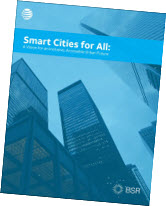New AT&T report promotes a people-first approach to smart city technologies
Tue, 2017-06-13 10:30
A survey conducted last year by nonprofits G3ict and World Enabled with 250 experts worldwide found that about 60% of global respondents believe smart cities are failing people with disabilities. So when tech heavyweights like Microsoft and AT&T get involved in a societal challenge – as they have with the Smart Cities for All initiative launched by G3ict and World Enabled — it’s a hopeful sign that solutions are forthcoming. – Philip Bane
Last month at Smart Cities NYC 2017, nonprofits G3ict and World Enabled launched their Smart Cities for All toolkit to help city leaders, urban planners and technology companies design accessible and inclusive smart cities for all citizens. It contains four tools to help smart cities include a focus on ICT accessibility and the digital inclusion of persons with disabilities and senior citizens.
The toolkit was a result of the Microsoft-supported Smart Cities for All initiative designed to help cities implement smart cities programs and services that engage all citizens across a broad range of areas – employment, public safety and financial services among them.
“As leaders driving digital transformation across business and government, we must make sure the benefits of technology innovation are broadly shared,” suggested Toni Townes-Whitley, corporate vice president of Worldwide Public Sector and Industry at Microsoft. “The Smart Cities for All toolkit empowers city leaders and urban planners to make their programs truly ‘smart’ by being inclusive and accessible by design.”
A people-first approach
 This week AT&T, in collaboration with Business for Social Responsibility, G3ict and World Enabled, launched a new white paper — Smart Cities for All: A Vision for an Inclusive, Accessible Urban Future. The report aims to help cities identify ways that smart city technologies can adopt a people-first approach to benefit people with disabilities and older citizens.
This week AT&T, in collaboration with Business for Social Responsibility, G3ict and World Enabled, launched a new white paper — Smart Cities for All: A Vision for an Inclusive, Accessible Urban Future. The report aims to help cities identify ways that smart city technologies can adopt a people-first approach to benefit people with disabilities and older citizens.
“As an Internet of Things leader, we realize all too well the positive impact smart cities solutions can have on improving and enhancing citizens’ lives,” said Chris Penrose, President, Internet of Things Solutions, AT&T Business. “While full of promise, the adoption of smart cities technology is still in its infancy. As more and more cities begin to consider and implement smart city strategies, our hope is that they will take a holistic approach so that they are taking into account the needs of all citizens, so that everyone can fully reap the benefits of technology innovation — now and in the future.”
The report notes that in the largest 100 metropolitan areas in the U.S. nearly 50 million people — or 25% of residents — are currently over the age of 65 or living with disabilities. With the size of the aging community expected to double by 2060, the report suggests “it is an imperative social responsibility to all citizens to make future cities more accommodating and supportive of these communities.”
And the challenge is worldwide.
“Just over one billion people worldwide live with a disability. So our challenge is to design and deploy smart city services that leave no one behind,” added Dr. Victor Pineda, President of World Enabled. “We can get smarter cities by investing in design for inclusivity and accessibility.”
4 keys to success
The report identifies four keys to success it recommends city officials use to ensure digital inclusion:
- Designing for inclusion. Universal design criteria will ensure technologies are usable by all citizens. Additionally, there are opportunities for cities to embed smart city solutions that will leapfrog barriers to adoption. Enhanced digital security and privacy protections will be a fundamental requirement as these new technologies will play a vital role in the lives of citizens – and may be directly responsible for the health and wellbeing of the most vulnerable communities.
- Engaging partners and stakeholders. Smart city technologies must adopt a multi-stakeholder engagement process to ensure sustainable financing of these innovations and citizens’ full participation in any projects. Partnerships with the private sector will help co-create cost-effective and viable solutions that leverage companies’ expertise in designing for inclusivity. Engaging aging communities and those living with disabilities in the planning of smart cities is critical to ensuring these solutions align with citizen needs and expectations.
- Promoting adoption of technology. City officials must work to bridge the digital divide that often prevents people who are aging or living with disabilities to access the full benefits of technology. Officials must work to empower these communities to participate in smart cities by increasing access both to broadband connectivity and connected devices, as well as the necessary technology education to fully utilize these benefits. Without addressing these issues, cities risk perpetuating disparities that keep these communities from accessing smart technologies.
- Fostering the entrepreneur ecosystem. Many of the applications and solutions that will benefit these communities will arise from social entrepreneurs and innovators of all ages. Beyond enhancing the accessibility of city infrastructure and services, a key role for city government is to enable this social innovation to flourish and direct entrepreneurship to benefit these communities. Publicly funded incubators and open data portals are some of the many ways city governments can foster citizen solutions.
This new vision for a more inclusive urban future will help cities across the U.S., Mexico and worldwide focus on digital inclusion and Smart Cities for All,” said James Thurston, G3ict’s Vice President for Global Strategy & Development.
Content retrieved from: http://smartcitiescouncil.com/article/new-att-report-promotes-people-first-approach-smart-city-technologies.
Upcoming Events
There are no upcoming events.





